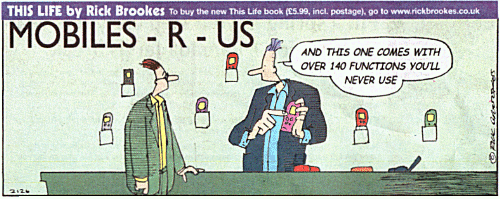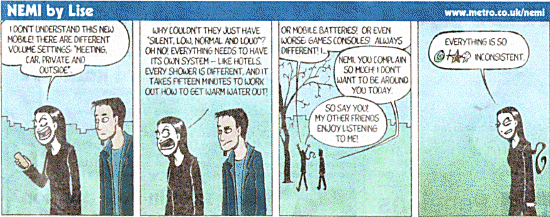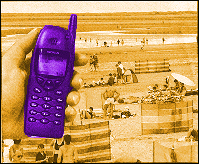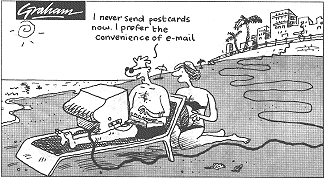It's bad to talk

Children don't care:They simply love mobile phones with a passion
Jenny McCartney
ANXIETY and paperwork were the only two things to come out
of Sir William Stewart's report into the safety of mobile phones, which finally
appeared last week. After lengthy deliberations, he could uncover nothing
to show that mobile phones have unsafe effects upon the brain. Nor could
he conclude that they are safe. He has therefore suggested that children
- with their dangerously flimsy skulls and greed for perpetual chatter -
should be prohibited "unfettered access" to them. Sir William's inconclusiveness
is not his fault. There have been a number of scientific studies into the
potential side-effects of mobile phones, and at the end of them we are as
wise as was the average medieval peasant when, with a slack jaw and crossed
eyes, he contemplated the mysterious workings of the moon. Researchers in
Freiburg, Germany, have claimed that the use of mobile phones increases blood
pressure. Dr Kjell-Hansson Mild in Umea, Sweden, has said that they cause
fatigue, headaches and skin irritation. Scientists at the University of
Washington, found rats exposed to mobile- phone microwaves are more likely
to binge on alcohol. Scientists at the University of Nottingham have found
that nematode worms grow faster but wriggle less when exposed to microwaves.
Dr Lennart Hardell, a Swedish cancer specialist, has claimed to find a
correlation between the side of the head on which mobile users hold their
handset and the location of tumours.

A team at the University of Bristol then found that the reaction
times of mobile-phone users became faster than those of non-users. Adults
have no idea whether a mobile phone will eventually transform their child
into a fast-growing binge-drinker with lightning reaction times and a tumour
the size of a grapefruit, or not. Their children don't care: they simply
love mobile phones with a passion. One in four of Britain's 24 million mobile
phone users is under 18. Last Christmas, according to a Woolworth' s survey,
mobiles were the presents most wanted by 10 to 15-year-olds. Teenagers are
obsessed with communication, mainly the communication of banalities. They
do it with insane commitment. I can remember bidding my schoolfriend goodbye
after school: once home I would sneak off upstairs and get straight back
on the telephone to her, sometimes for an hour, hogging the family phone-line
as we plucked over the skeins of the dull day in exquisite detail. No matter
that we would see each other first thing the following morning; no matter
that serious people with work-related messages for other family members might
be dashing their heads against walls in frustration at the persistence of
the engaged tone. A teenager in possession of a telephone is a creature utterly
without conscience. That is why teenagers want mobile telephones : to pursue
their ridiculous, interminable conversations in secrecy, and at any time,
without the looming shadow of a watch-tapping parent. They get mobile phones
for a different reason - because they have convinced their parents, the poor
saps, that a mobile is necessary for "safety reasons". The safety argument
has become the weakness of modern parents, especially middle-class parents.
As real risk to children has decreased, parents'
perception of such risk has soared. In the days when children were regularly
carried off by cruel fate - in the form of scarlet fever, or diphtheria,
or a carelessly reversed milk-lorry - parents were more devil-may-care about
the whereabouts of their offspring. Minors were permitted to roam streets
and woodlands with impunity, on condition that they returned at an appointed
hour. In Enid Blyton's Famous Five books, the four children were forever
haring off to investigate smugglers' coves, nipping backstage at circuses,
and getting embroiled in fierce arguments with angry, moustachioed men. Their
adult supervisors, Uncle Quentin and Aunt Fanny, were remote and disinterested
figures, emerging from the shadows only occasionally to offer a scrap of
philosophical wisdom or to hand over a packed lunch. Were the Famous Five
written to reflect children' s lives today, the four would rarely be free
of the oppressive presence of Uncle Quentin and Aunt Fanny. They would be
picked up individually in a car from afternoon music lessons, and - if they
wished to socialise - driven to a friend's house, in which they might pass
a few happy hours with the Playstation or the Gameboy, before being collected
once more and driven home to bed.

The modern parent has been conditioned by fevered media reports
to believe that town centres, beaches, woodlands and fairgrounds - once the
happy hunting grounds for loose packs of children - are now peopled entirely
by lunatics and paedophiles. When their children insist on going to such
places, as children will, the parents sit at home, fretting. The mobile phone,
for all the irritation of its variable ringing-tones and sky-high bills,
appeared to offer parents a way out of their anxieties, an electronic apron-
string to their wandering children. Now, thanks to the Stewart report, it
is itself a font of anxiety. For it will always be impossible to give a child
a mobile phone, and persuade them to use it only in emergencies. Children
don't want to use the phone to inform parents of their whereabouts, or to
reassure them that they have not - as yet - developed any mobile-related
syndromes. They want to talk about last night's EastEnders with their friends.
For hours and hours.

Jenny is absolutely right,the media
takes any story where there is some risk and terrifies its readership into
thinking the dangers posed are way beyond what they actually are.Even during
the BSE crisis were thousands dropping like flies?
No. The perception of risk from technology is due to the
public distrust of science,the perception that
man made objects are inherently dangerous.For the most part this is based
on a fear of the unknown; people's inadequate understanding of how technology
works and the capacity to be innumerate,unable to make clear and concise
determination of what danger is actually posed by and conceivable threat.
Thus we get the knee-jerk and ill-thought out reactions to media hyped stories
and "Frankenstein" type scenarios of "meddling with life" via GM foods from
semi-religious writers who owe some kind of allegiance to ethics that are
in them by default,or else are actually practiced in the from of some religious
worship. Those ethics,very much like those of
HRH Prince of Wales,presume
that if we used the intuition of our hearts it will tell us something more
or superior to the thoughts of our heads,or be more informative than actual
statistics calculated for dangers such as any supposed threat of cancer from
cell-phones.This "intuition" is based on half
understood myths, rumours, hearsay, ignorance and an incapacity to come to
terms with facts or mathematics.No matter how many reports are published
testifying to the safety of objects such as cell phones ,there is still a
murmur of dissent,that the public should have to
"trust" what is told to them about technology.
They have no need to take the word of science,they should be able to figure
it out for themselves. But because of their innate aversion to things
scientific,they refuse to find out the facts themselves,and so are at the
behest of media hype. The public outcry is often accompanied by a lone voice
asking why it is that technology is never 100% safe,seemingly oblivious to
the naivety of this question. Nothing is 100% safe - ever.All science can
do is "minimise" risk. There are known causes and effects between cancers
and smoking,and the advice is that you are increasing risk of cancer through
smoking,yet people continue to smoke - why? Because it's an acceptable risk?
Can any smoker say in percentage terms what the risk is? Probably not,and
yet smokers may also be among the people who are scared of getting cancer
from cell phones. Sitting in front of TV or VDU screens all day poses a
risk,charged particles beamed at the phosphor are what excites the screen
to produce a picture.In other words "radiation" is emanating from TV screens,and
yet no one has ever caused a "TV screen scare" - Why?
The word "radiation" itself may have conurtations for people,based on its
associations with nuclear fallout. EM
(Electromagnetic) radiation is all around us,both man-made and natural,and
yet no one ever worries about radiation from then sun-unless that is,there
is "scientific evidence" linking UV radiation with melanomas, which there
is. Microwave ovens are used regularly,and have a "magnetron" inside which
creates microwave "radiation". Radio Transmitters create "radiation" much
more powerful than any cell phone, and yet no one cries out in alarmist fashion
about the dangers of Radio transmissions. Radar used by the military and
commercial airlines emits radiation. My physics teacher once told me the
story of the guy who worked bringing in aircraft to land whose insides were
slowly microwaved by the radar left switched on,in the aircraft he was guiding
in.Distance to the source of radiation and its screening by shields makes
a difference to its capacity to affect tissue. If you check you technology
you will like as not find a tag which says what classification of radio emissions
it complies with.Some emanations can be picked up by a radio receiver indicating
that they are being emitted in the local vicinity.So such things as PCs and
musical digital keyboards (computing devices) emanate radio frequency emissions
by virtue of the speed of the electronic processors.This is not necessarily
anything to worry about,as the frequency of the emission makes a difference
as does the amplitude.
When we go into hospital we use
X-ray and MRI and PET scanners all which
use different frequencies of EM radiation in different ways,and don't forget
light is a form of EM radiation too.One cannot tar them all with the
same brush. X-ray machines invariably are shielded and use kept to a
minimum.Magnetic resonance imagers use high strength magnetic fields which
is not so much radiation as a "field" of energy.We use such machines when
hospitalised with apparently no thought to any potential danger.Presumably
because the device is in a hospital and is supposed to aid our health not
diminish it.
Most everyone will be familiar with the lines of force generated around a
bar magnet with iron filings.This pattern shows the local effect of the
field.Such fields are also available in TV screens to keep the electrons
in place on the screen.Moving a magnet close to the screen will deflect the
beam and distort the picture.
But it can readily be seen that with weak magnets the effect falls of quickly
with distance. Some of the problem with cell phones has been the idea that
radiation can be "focussed" along the direction of the aerial creating a
concentration of energy in the head.That may be a concern.But if you compare
this with the focussed beam of electrons on a TV screen,it seems a bit bizarre
to worry about it. As with the guy whose insides were microwaved this happened
over a period of time as he systematically was exposed to point sources of
radiation of a powerful nature.Cell phones aren't nearly as powerful as a
radar system,but the phone is commensurately nearer the head. I think people
underestimate the capacity of the manufacturers and safety guidelines which
such products are subject to before release. If one takes a magnifying glass
and focuses the suns "radiation" onto your skin,it is readily apparent what
damage it can do,but if one does the same thing with a household light bulb,there
will be no noticeable smell of burning flesh.If one has concerns over such
items,it is incumbent upon the user to check the facts,and not get hysterical
because some media writer with no story to tell emphasises risks in order
to sell a newspaper or get a bigger audience for a TV programme. Still
further,those with beliefs,or an axe to grind with modern technology, seize
upon public fears to try to undermine modern methods and send us backwards
to presumed
"halcyon" periods when their was less risk.
In actual fact times of old,were more risky,because no one was paying attention
to risk. If you have a problem with technology, and suffer at its hands,its
your own fault for not understanding it. You play with fire and get burnt.It's
up to the person in question to be responsible and learn about what fire
is,and does,before making use of it.The public is audacious enough to take
the benefits of technology without heeding the instruction manual and then
carp when they suffer through their own ignorance of risk, mathematics, and
physics. It is not the scientists fault if they come a cropper,it is the
person who neither understands nor respects,the objects which they readily
make use of.
-LB

Oh,we do like to text beside the seaside |

I fear the time has come to bid farewell to saucy seaside
postcard.No more pictures of henpecked husbands with red noses under constant
verbal bombardment from indignant wives with mountainous bosoms and elephantine
backsides.
|
Writing without vowelsJohn C. Marshall |
| IN this issue (page 2581) Roberto Cubelli reports a novel
(and quite unexpected) form of writing deficit. Two Italian-speaking patients
who had suffered damage to the left hemispheres of their brains were selectively
impaired on writing vowels. Disorders of writing and spelling (the dysgraphias) are a frequent consequence of damage to the left hemisphere. If adults who were previously fully literate, suffer stroke, tumour or trauma that involves left parieto-occipital cortex in particular it is highly likely that significant reading and writing impairments will result. These problems will usually, but not inevitably, be found in the context of more widespread disorder in the expression and comprehension of spoken language (aphasia), with concomitant involvement of temporal cortex. The qualitative nature of acquired dysgraphia can assume many forms. Some patients write what they hear, and will thus (in English) transcribe yacht as yot, laugh as laf, or room as rewm2. Equivalent errors from French patients include photo written as fauto, and pigeon as pijon3. Mistakes of this type occur both in spontaneous writing and in writing to dictation. Other patients write (approximately) what they (or the examiners) mean. Cake may be written as bun, star as moon, or nephew as uncle4. Comparable errors reported in French are crabe written as homard, auto as voiture, and biche as gazelle5. Some patients show that they recognize their own spelling problem by simply leaving out the letters they are unsure of. For instance, one patient attempting to produce the names of countries wrote: In a; Tur y; and C na6. Cubelli's two subjects, who had suffered left-hemisphere infarcts, manifested a curious variant of this deficit. The first (C. F.) was similar to the case just mentioned in that he left spaces for the 'unavailable' letters; but unlike that earlier case, the missing items were always vowels. For example, requested to write the name of the town in which he lived, C. F. wrote B L G N. There is no obvious reason why vowels should be more difficult to 'remember' than consonants or more difficult to execute motorically. One might, however, reflect tht whn y wrt wtht vwls the message is still (fairly) clear, but e ou ie iou oe. The former option was, of course, adopted for Phoenician script, and can still be seen (to a first approximation) in modern (unpointed) Hebrew7. C. F.'s stroke had resulted in a right-sided hemiplegia, and the patient was therefore forced to write with his left (non-dominant) hand. It is thus possible (but intuitively unlikely) that C. F. 's pattern of performance was a 'strategic' adaptation to the difficulty of writing with his left hand; Fig. 1 (page 259) of Cubelli's report shows some shakiness in the execution of the (upper case) letters that C. F. produced. The second case (C. W.), however, had no hemiplegia and wrote with his (preferred) right hand. His performance cannot by any stretch of the imagination be made to fit this 'strategic' hypothesis. C. W. did make some errors on consonants, but there was an overwhelming preponderance of vowel errors. More crucially, C. W. did not (typically) omit vowels (as C. F. did); rather, 90 per cent of his errors were substitutions or transpositions. For example, dietro (behind) was written as diatro, and caro (dear) as cora. These two responses, like the vast majority that Cubelli reports C. W. as making, are possible but not actual Italian words. The pattern of performance was constant across a range of relevant tasks: written and oral spelling, typing, and delayed copying. In all instances, vowel errors were significantly more frequent than consonant errors. The critical question is where in the functional architecture of the spelling system could such errors arise. C. W. 's error rate is not affected by lexical variables: he makes the same proportion of errors irrespective of whether he is writing high or low frequency words, abstract or concrete words, or indeed words or nonwords. Likewise, the errors themselves are not constrained to be (attested) words. The disorder thus seems to have no involvement with central lexical processes. Neither is it the case that C. W. has 'lost' the graphemic representations of vowels as such; he can write single vowels and syllables to dictation without error. Substitutions, transpositions and omissions occur only when a multisyllabic sequence of letters is required. The conclusion, then, is that there is impairment of a short-term memory system specific to written (and oral) spelling -the 'graphemic buffer'. The deeper question of why this graphemic buffer should be sensitive to the phonologically based distinction between vowels and consonants remains open. C. W. has good (but not perfect) immediate repetition of the words and nonwords that give rise to such high levels of writing errors (Table 1, page 259). One would like to know if delayed oral repetition showed errors selectively concentrated on vowels. Cubelli argues that "the consonant/vowel status of graphemes is differentially specified in the spelling process and may be selectively affected following brain damage" but this selectivity may not be truly specific to writing. It is furthermore difficult to imagine that the direction of the effect could be reversed in other patients. Roberto Cubelli has shown that a dysgraphic patient could write that name as R B R T C B LL ;but the odds do not appear favourable that we shall ever find his name transcribed as O E O U E I.
1.Cubelli, R. Nature 353, 258-260 (1991). |
